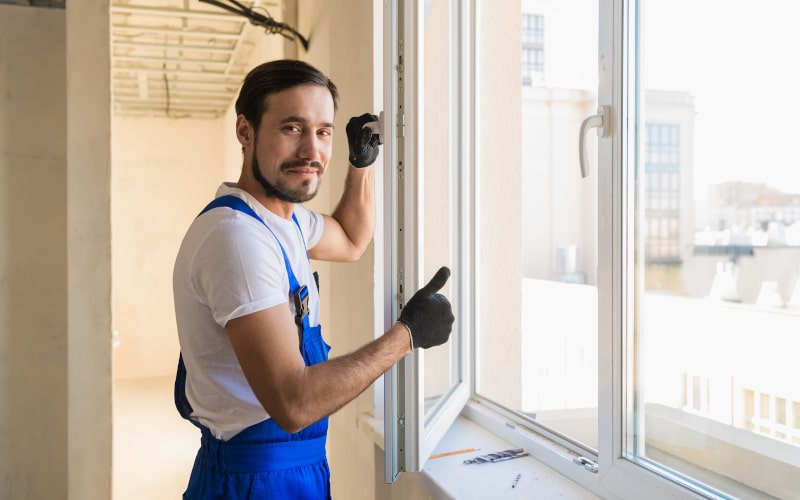How Glass for Windows Is Made: A 101 Guide

You see them every day, but probably don’t give them much thought (until it’s time to replace one). Glass windows might seem simple, but a lot is going on behind that clear pane. From raw materials to high-performance coatings, modern glass for windows offers us homeowners more than aesthetics.
For many, it's a way to make the home safer and more energy-efficient without compromising on appearance, and knowing how it’s made? That can help you understand what you’re buying when you upgrade your windows or doors.
In this guide, we will pull back the curtain on how today’s glass windows are manufactured, step by step. We will also examine how manufacturers form and treat glass to enhance its resistance to damage and improve insulation. Knowing a few key details, such as what makes it suitable for Canadian winters (and summers, too), will help you select the right type of glass for your needs.
Key Takeaways
- Glass window manufacturing has advanced with eco-friendly methods for better efficiency and sustainability
- Float glass is the most common type as it offers clear visibility and a smooth surface
- Low-E glass and IGUS enhance energy efficiency by regulating indoor temperatures throughout the year
- Safety features, such as impact-resistant and fire-rated glass, enhance security and durability
- Smart glass enables control over light and heat, providing improved privacy and energy savings
What is the Glass Manufacturing Process?
The process of making glass windows begins with the combination of natural raw materials. These materials are usually silica sand, limestone, and soda ash. With them, manufacturers use other components, such as alkali metal oxides, borates, and dolomite.
With all of them together, the manufacturers heat them to temperatures that sometimes exceed 1,500°C °c. That is where the materials melt into a liquid form. And once they melt, manufacturers form glass using different methods, which depend on the type of glass desired.
The most common technique today is float glass processing. This is where the manufacturer will float molten glass on a bed of molten tin to produce a smooth, flat surface. But there are alternative methods as well. For example, when rolling or drawing sheet glass, the molten material must be stretched or pulled into the desired shape.
Moreover, recent advancements have also enabled us to adopt eco-friendly production methods, allowing us to reduce energy consumption and waste. For example, we often see recycled glass in use in the manufacturing process. Additionally, many manufacturers are adopting low-emission techniques to minimize the overall environmental impact of these processes.
Types of Glass Used in Windows
Yes, most windows are made of glass and may even undergo similar manufacturing processes. But that doesn’t mean all glass types are the same. The type of glass used in manufacturing will affect the window’s performance, energy efficiency, security, and longevity. So, here are some of the most commonly used types:
1. Float Glass
This is the standard glass in most windows. It's created through the float glass method, which leads to a smooth, flat surface. As a result, it’s suitable for clear visibility and regular use.
2. Low-E Glass (Low Emissivity Glass)
Then, we have Low-E glass, which features a thin, transparent layer that reduces heat transfer. This coating helps block ultraviolet (UV) rays from the sun. At the same time, it allows natural light to enter the home. Why Low-E coatings? They keep heat inside during winter and reflect it outside in the summer. In turn, this improves energy efficiency and reduces heating and cooling costs for you.
3. Insulated Glass Units (IGUS)
We also have IGUS, which consists of two or more panes of glass. The space contains air, and sometimes different types of gases for insulation purposes. Their design is primarily aimed at improving thermal insulation and helping homeowners regulate their indoor temperature. They are particularly effective in reducing heat transfer and external noise.

4. Triple-Pane Glass
For an additional layer of insulation, consider triple-pane glass. It is an extremely popular choice for homes in extreme climates. It has three layers of glass and two air spaces between them. As a result, these windows give you better insulation properties for your windows. Additionally, triple-pane windows offer a superior soundproofing rating. This means you can maintain control over both temperature and noise levels.
5. Tempered and Laminated Glass
You may already be familiar with tempered glass, as it frequently appears in advertisements for the latest smartphones and LED displays. This type of glass undergoes heat treatment to enhance its strength and prevent it from shattering into sharp pieces.
This makes it a safer option for areas that might be prone to accidents or high traffic. Another variety within this is laminated glass. It sandwiches a layer of plastic between two layers of glass for additional benefits, such as preventing shattering and enhancing overall security. You will often see it in use across storm-prone regions for impact resistance.
6. Smart Glass
One of the most exciting innovations in glass technology is smart glass, which can change its transparency in response to electrical currents. This means that you can control the amount of light and heat that enters your home. So, you get better energy efficiency and privacy control. Moreover, it remains a modern option that's still undergoing development for newer home designs.
What Type of Glass Coatings Are There (and Why)?
In addition to the type of glass itself, coatings play a significant role in determining window performance. To help you better understand, we have simplified the most commonly used glass coatings below.
Low-E Coatings
Low-E coatings come in two types: hard-coat and soft-coat. Both types help reduce heat loss, but soft-coat Low-E glass is typically more effective in colder climates because it offers superior insulation. These coatings will play a key role in making your home more energy-efficient by reducing the need for heating and cooling.
Solar Control Coatings
What do solar control coatings do? They help you control the amount of sunlight that enters your home. Solar control coatings can reduce glare and prevent excessive heat buildup indoors. As a result, you can create a comfortable environment more easily.
Self-Cleaning Coatings
A more recent innovation in glass windows, self-cleaning coatings utilize sunlight to break down dirt and debris. Consequently, the coating makes maintenance easier and is particularly useful for windows that are hard to reach or in areas with frequent rainfall.
UV Protection Coatings
UV rays are sneaky. They can fade your furniture and carpets over time, and they’re also not great for your skin. This type of coating blocks those rays from coming through your windows, keeping your interiors looking fresh and your skin safe. Plus, it’s one less thing to worry about on sunny days.
Safety Features and Durability
What else do modern glass windows offer? They offer more enhanced and better reinforced safety and security features. While the following aren’t the most recent developments, they’re still big in the market:

Impact-Resistant Glass
If you live in an area prone to storms, impact-resistant glass is a must-have for your home. This glass is tough, designed to withstand high winds and flying debris without shattering. It keeps your home safer during bad weather, so you don’t have to worry about glass breaking and causing damage or injury.
Fire-Rated Glass
For homes or buildings where fire safety is a top priority, fire-rated glass is the go-to choice. This glass is specially designed to handle high temperatures, slowing down the spread of fire. In an emergency, that extra time could make all the difference to give you more time to evacuate or for firefighters to do their job.
Tempered vs. Laminated Glass for Safety
Tempered glass is the go-to for strength and safety – it’s heat-treated to be tougher than regular glass, so it won’t shatter easily. However, if you're seeking an added layer of protection, laminated glass is the ideal choice. With a plastic interlayer, it remains intact even if it cracks, making it a great option for ground-level windows or high-traffic areas where safety is paramount.
What to Consider When Choosing Glass for Window

Choosing the right glass is more important than you might think. It affects everything from energy efficiency and security to comfort and noise levels. Here's a breakdown of key factors to help you pick the best glass for your needs.
Energy Efficiency: Keeping Your Home Comfortable Year-Round
When it comes to energy-efficient windows, Low-E glass is a popular choice. It works by reflecting heat into your home during the winter and blocking out the summer heat. On the other hand, IGUS are another great option.
They have multiple panes that provide excellent thermal insulation. For places with extreme weather, triple-pane glass is ideal because it offers better insulation with an extra layer of glass and air gap. These options help keep your home comfortable and can lower your energy bills throughout the year.
Climate: Adapting to the Weather Outside
The climate plays a huge role in choosing the right glass. If you live in an area with extreme temperatures, triple-pane glass is the ideal choice. It can handle both winter cold and summer heat, thanks to its extra layer and air gap.
For even colder climates, vacuum-insulated glass (VIG) is a top-tier option – it eliminates air gaps for maximum energy efficiency. However, if your weather is more moderate, double-pane glass with a Low-E coating should suffice without the higher cost of triple-pane glass.
" At the heart of every successful project is a clear vision and seamless collaboration. It’s about ensuring each step, no matter how small, contributes to the bigger picture, while staying focused on quality and efficiency. " – Tony Wong, Project Manager.
Security: Protecting Your Home and Family
Let’s not forget about security; it’s another major factor to consider. First option, tempered glass, is a tough choice. It’s heat-treated to break into small, blunt pieces, which lowers the risk of injury.
Meanwhile, laminated glass with its plastic interlayer is even more durable. It’s harder to shatter and keeps the glass intact even if it’s cracked. Both types are great for extra security, whether you're worried about break-ins or severe weather.
Soundproofing: Reducing Noise for a Peaceful Home
And if you’re looking to reduce noise, insulated glass and triple-pane options are ideal. The layers and air gaps reduce the transmission of sound. In turn, it makes them ideal for noisy neighbourhoods or if your home is near busy roads.
Additionally, laminated glass can enhance soundproofing. It absorbs sound waves more effectively than other window options, making it an ideal choice for a noisy neighbourhood. So, whether you want to block out street noise or create a peaceful home office, these glass types are a great choice.
Conclusion
Yes, glass windows have come a long way. And it is thanks to the advancements in production techniques and materials. Due to modern techniques and technologies, we have glass windows and doors that can last for years.
Whether it’s energy-efficient Low-E glass or impact-resistant, fire-rated options, you'll find an option that suits you. Just make sure you’re checking out the variety with the right company to make your home a more comfortable and secure place.
At Canadian Choice Windows & Doors, we’re here to help you choose the right glass for your home. Do you want to save on energy bills, increase security, or boost overall performance? Contact our team, and we will assist you in making an informed decision.
1000’s of Colours & Textured Finishes
Transform your home from ordinary to extraordinary with our new coloured and non-glare textured finishes. Available in a wide array of colours as well as custom matched colours for your very own personalized design.
Our Most Popular Replacement Window Colours:










